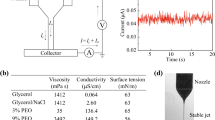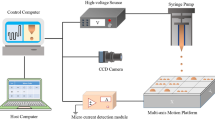Abstract
In this paper, electro-hydraulic coupling jet printing technology based on the Weissenberg effect is put forward for the first time, and the pulse voltage is used to realize the on-demand printing. The experimental results show that the Weissenberg effect can inhibit the solution reflux and make the solution converge into a cone tip at the nozzle, which is more conducive to position printing precisely. By exploring the influence principles of process parameters on printing, it is found that droplet diameter is positively correlated with rotation speed and negatively correlated with voltage frequency. The printing frequency is negatively correlated with the rotation speed and positively correlated with the voltage frequency. However, the effect of voltage amplitude and duty ratio on the printing effect is not obvious in a certain range. It is found that the rotation speed of needle core within the range of 1800 r/min-7500 r/min can print out the ideal lattice structure, which proves the feasibility of this system to realize on-demand positioning printing. Finally, by using the printing equipment, the sacrificial layer structure of PDMS microfluidic chip was successfully made and the function of the microfluidic chip was realized, which further verified the practicability of the technical scheme proposed in this paper.
Similar content being viewed by others
References
J. U. Park et al., High-resolution electrohydrodynamic jet printing, Nature Materials (2007) 1–9.
T. Subbiah et al., Electrospinning of nanofibers, Journal of Applied Polymer Science, 96 (2005) 557–569.
D. H. Sun et al., Near-field electrospinning, Nano Letters, 6(4) (2006) 839–842.
L. Xu, X. Wang, T. Lei, D. Sun and L. Lin, Electrohydrodynamic deposition of polymeric droplets under low-frequency pulsation, Langmuir, 27(10) (2011) 6541–6548.
L. Xu and D. Sun, Electrohydrodynamic printing under applied pole-type nozzle configuration, Applied Physics Letters, 102(2) (2013) 024101.
K. Weissenberg, A continuum theory of rheological phenomena, Nature, 159(4035) (1947) 310–311.
J. Yoo, D. D. Joseph and G. S. Beavers, Higher-order theory of the Weissenberg effect, Journal of Fluid Mechanics, 92(3) (1979) 529–590.
G. S. Beavers and D. D. Joseph, Experiments on free surface phenomena, Journal of Non-Newtonian Fluid Mechanics, 5 (1979) 323–352.
G. S. Beavers, J. Y. Yoo and D. D. Joseph, The free surface on a liquid between cylinders rotating at different speeds, Part III, Rheologica Acta., 19(1) (1980) 19–31.
W. C. MacSporran and R. P. Spiers, The dynamic performance of the Weissenberg Rheogoniometer, Rheologica Acta., 21(2) (1982) 184–192.
D. D. Joseph and G. S. Beavers, Free surface problems in rheological fluid mechanics, Rheologica Acta., 16(2) (1977) 169–189.
W. Wang, Experimental Study on Electrospinning Direct Writing Jet Constraint and Positioning Deposition based on Weissenberg Effect, Xiamen: Xiamen University (2015).
E. S. D. Lid, Integrated microfluidic devices, Analytica Chimica Acta., 507 (2004) 11–26.
G. M. Whitesides, The origins and the future of microfluidics, Nature, 442 (2006) 368–373.
L. Xu, Jetting Behaviors of Pulsated Single-jet Based on Electrohydrodynamics, Xiamen: Xiamen University (2010).
Acknowledgments
This work is supported by research program by ChaoHu University (Research on Distributed Coordinated Control Strategy of Microgrid Based on Probabilistic Power Flow Analysis, Project ID: XLZ-201702), China.
And this work is also supported by the Anhui province (Provincial Quality Project of Universities in Anhui Province, Project ID: 2019jyxm0395), China.
Author information
Authors and Affiliations
Corresponding author
Additional information
Jing Wang is a Lecturer of the School of Electronic Engineering, Chaohu University, China. She received her Master’s degree in Control Theory and Engineering from Anhui Polytechnic University. Her research interests include Micronano manufacturing, optimal algorithm, intelligent control theory and application.
Rights and permissions
About this article
Cite this article
Wang, J., Wu, X., Wang, W. et al. Electro-hydraulic coupling jet printing technology based on Weissenberg effect under pulse voltage. J Mech Sci Technol 35, 2585–2592 (2021). https://doi.org/10.1007/s12206-021-0529-9
Received:
Revised:
Accepted:
Published:
Issue Date:
DOI: https://doi.org/10.1007/s12206-021-0529-9




